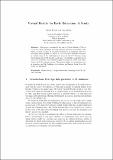Files in this item
Virtual Reality for early education : a study
Item metadata
| dc.contributor.author | Fabola, Adeola | |
| dc.contributor.author | Miller, Alan | |
| dc.contributor.editor | Allison, Colin | |
| dc.contributor.editor | Morgado, Leonel | |
| dc.contributor.editor | Pirker, Johanna | |
| dc.contributor.editor | Beck, Dennis | |
| dc.contributor.editor | Richter, Jonathon | |
| dc.contributor.editor | Gütl, Christian | |
| dc.date.accessioned | 2017-03-07T10:30:15Z | |
| dc.date.available | 2017-03-07T10:30:15Z | |
| dc.date.issued | 2016 | |
| dc.identifier | 249288097 | |
| dc.identifier | e4dfe86f-44bf-44c7-9023-1b97e799c025 | |
| dc.identifier | 84978951885 | |
| dc.identifier | 000389515200005 | |
| dc.identifier.citation | Fabola , A & Miller , A 2016 , Virtual Reality for early education : a study . in C Allison , L Morgado , J Pirker , D Beck , J Richter & C Gütl (eds) , Immersive Learning Research Network : Second International Conference, iLRN 2016 Santa Barbara, CA, USA, June 27 – July 1, 2016 Proceedings . Communications in Computer and Information Science , vol. 621 , Springer , Cham , pp. 59-72 , iLRN 2016 Conference , Santa Barbara , California , United States , 27/06/16 . https://doi.org/10.1007/978-3-319-41769-1_5 | en |
| dc.identifier.citation | conference | en |
| dc.identifier.isbn | 9783319417684 | |
| dc.identifier.isbn | 9783319417691 | |
| dc.identifier.issn | 1865-0929 | |
| dc.identifier.other | Bibtex: urn:3a4da4226e5616923a39c54bd5620e8a | |
| dc.identifier.other | ORCID: /0000-0003-1209-9063/work/40546674 | |
| dc.identifier.uri | https://hdl.handle.net/10023/10409 | |
| dc.description.abstract | This paper investigates the use of Virtual Reality (VR) as a tool for cultural heritage learning, using St Andrews Cathedral as the subject matter. As part of a module focused on local history, first year secondary school pupils in a school in the town of St Andrews took part in virtual tours of the Cathedral as it stood in the 14th Century using the Samsung Gear VR, Google Cardboard, Oculus Rift, computer screen and Xbox controller, and answered questions aimed to elicit their experiences with the various systems. The system design and implementation is presented and the findings, observations and lessons learnt from the study are discussed. | |
| dc.format.extent | 14 | |
| dc.format.extent | 22930757 | |
| dc.language.iso | eng | |
| dc.publisher | Springer | |
| dc.relation.ispartof | Immersive Learning Research Network | en |
| dc.relation.ispartofseries | Communications in Computer and Information Science | en |
| dc.rights | © 2016, Springer International Publishing Switzerland. This work has been made available online in accordance with the publisher’s policies. This is the author created, accepted version manuscript following peer review and may differ slightly from the final published version. The final published version of this work is available at link.springer.com / https://doi.org/10.1007/978-3-319-41769-1_5 | en |
| dc.subject | Virtual reality | en |
| dc.subject | Google Cardboard | en |
| dc.subject | Samsung Gear VR | en |
| dc.subject | Cultural heritage | en |
| dc.subject | LB Theory and practice of education | en |
| dc.subject | QA75 Electronic computers. Computer science | en |
| dc.subject | NDAS | en |
| dc.subject | SDG 11 - Sustainable Cities and Communities | en |
| dc.subject.lcc | LB | en |
| dc.subject.lcc | QA75 | en |
| dc.title | Virtual Reality for early education : a study | en |
| dc.type | Conference item | en |
| dc.contributor.institution | University of St Andrews.School of Computer Science | en |
| dc.contributor.institution | University of St Andrews.Centre for Higher Education Research | en |
| dc.identifier.doi | 10.1007/978-3-319-41769-1_5 |
This item appears in the following Collection(s)
Items in the St Andrews Research Repository are protected by copyright, with all rights reserved, unless otherwise indicated.

